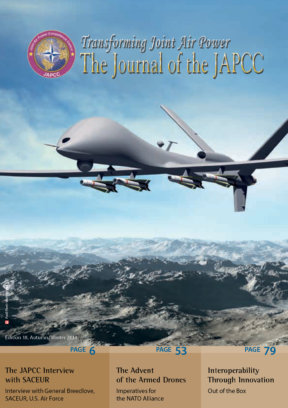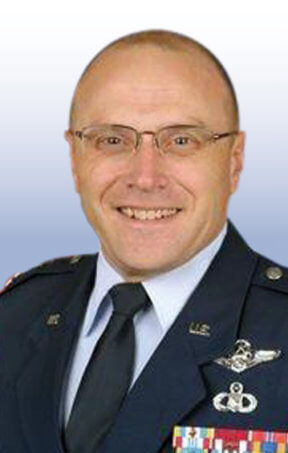Introduction
In 1978, 12 member nations of the North Atlantic Treaty Organization (NATO) joined together in a one-of-a kind agreement to provide an Airborne Early Warning and Control (AEW&C) capability to the Alliance.1 Originally procured to overcome a serious deficiency in the air defence system of the time, over the past thirty years the NATO E-3A Airborne Warning and Control System (AWACS) aircraft has evolved into a highly capable airborne Command and Control (C2) platform. Now 16 nations strong, the NATO E-3A Component, which employs NATO’s 17 E-3A AWACS aircraft, has evolved and remains a capable and ready force, still relevant to the employment of NATO airpower.
Given the genesis of the E-3A Component as a counter to the low fast-flying air threat of the 1970s one may ask, “How can an organisation built to counter a 1970s air threat remain relevant to airpower employment today?” Although this might be a subject for debate, it is difficult to dispute that since 28 June 1982, the official activation date of the E-3A Component, NATO commanders elected to employ the NATO AWACS in nine different operations. With NATO Operation ANCHOR GUARD in 1990 and NATO Operation UNIFIED PROTECTOR in 2011 is a window of more than two decades of NATO AWACS missions providing sustained support to on-going operations. Between 1992 and 2004 the E-3A Component flew over 10,000 mission sorties supporting NATO operations in Bosnia and Herzegovina. This appetite for NATO AWACS capability was fuelled by one overarching factor – location.
Areas of Interest
Where these NATO operations were conducted clearly drove a requirement for the employment of NATO AWACS. Six of the nine NATO operations supported by the E-3A Component were conducted outside the territory of NATO nations. Two of the remaining operations were conducted inside the airspace of NATO nations but focused across the border on non-NATO states. For example, in 1990 NATO AWACS were operated along Turkey’s border with Iraq. In 1992, NATO AWACS could be found operating in international airspace along the border of Libya and in the sky above Bosnia and Herzegovina. In 2011, NATO AWACS were on-station over Afghanistan and once again operating along the border of Libya.
Based on the location of these operations, existing NATO ground based surveillance and C2 systems could not support the associated areas of responsibility. Almost unexpectedly, NATO commanders had an operational requirement to extend the reach of both their surveillance and C2 capability beyond the boundaries of the NATO nations. By 1992, delivering a capability to fill this requirement became an important part of the mission of the E-3A Component.
As a result, in a relatively short timeframe, the E-3A Component evolved from an organisation focused on employing the NATO AWACS above NATO nations to provide low-level radar coverage to augment NATO ground based air defence systems to an organisation skilled in extending the reach of NATO C2 and surveillance capabilities beyond the borders of the NATO nations. This evolution has produced an E-3A Component with a mission much different than the mission envisioned in 1978.
Today, the mission of the E-3A Component supports the overall mission of the NATO Airborne Early Warning and Control Force (NAEW&CF) which is
“To provide an Airborne Early Warning and Battle Management Command and Control capability trained and equipped to participate in NATO approved operations worldwide, available at graduated levels of readiness, to support nominated Joint Force or NATO Response Force (NRF) commanders.”2
When compared with an early version of the E-3A Component mission statement which read in part, “to deliver a surveillance and/or control platform whenever directed … by SACEUR”,3 the evolution is seen in three areas; the shift from a pure surveillance and control platform to an Airborne Early Warning, Battle Management and C2 capability, the addition of the E-3A Component to the NRF, and the expansion to worldwide operations.
Evolution
The evolution from the mission of providing a surveillance and control platform to the mission of providing Battle Management and C2 in support of Joint Force commanders has increased the spectrum of mission elements supported by the E-3A Component. No longer are NATO AWACS missions exclusively linked to supporting air defence systems with surveillance and control. Instead, NATO AWACS aircrews are tasked to be proficient and ready to conduct ten different mission elements under the umbrella of surveillance and airborne early warning and 19 capabilities identified for airborne air battle management and Command and Control as described in Allied Command Operations Forces Standards Volume III.4
Be certain, providing air surveillance and control to support the employment of NATO airpower remains the core mission of the E-3A Component. However, these increasing number of mission elements reflects the reality that NATO airpower is employed in NATO operations to conduct a wide range of mission sets beyond air defence. Further, it reflects how NATO AWACS systems are easily adapted to other mission sets, important to on-going NATO operations as well. For example, the maritime radar receiver on the E-3A aircraft has not changed in 30 years. Yet NATO AWACS is still an effective asset for NATO counter piracy operations.5 Maritime Operations is one of the ten mission elements tasked to NATO AEW&C.
Further, Tactical Directors, officers who hold overall responsibility for the execution of the NATO AWACS mission, are trained to accept delegation of specific tactical battle management functions to support the C2 of airpower. Inherent in this delegation is a degree of autonomy where NATO AWACS aircrews are delegated tactical authorities which enable tactical action based on real-time information. This delegation allows NATO AWACS aircrews to operate independent of the NATO air C2 structure and the traditional command arrangements employed through the NATO Combined Air Operations Centres. During Exercise RIMPAC 2012, NATO AWACS aircrews demonstrated the ability to operate independent of the NATO air C2 structure while supporting many mission elements supporting airpower employment.
In response to the rapid employment concepts required of the NATO Reponses Force, and the requirement for worldwide operations, the E-3A Component has improved overall readiness in areas beyond aircrew flying training. Civilian and military members of the E-3A Component maintain an annual currency in a set of common core skills necessary to sustain operations at an austere location. Expeditionary deployment concepts are established which could enable NATO AWACS operations from any operational air base.
On-going E-3A Component operations supporting the NATO International Security and Assistance Force in Afghanistan are, perhaps, an acknowledgement of the evolution the E-3A Component has made. Aircrews are conducting operations in support of ground and Special Operation Forces (SOF). (An additional expansion of the AEW mission elements beyond the ACO Force Standards). The E-3A Component has adapted an expeditionary mind set, sustaining a very high mission effectiveness rate from a Deployed Operating Base (DOB).
Throughout this evolution there has been an enduring constant – the people. Creating and maintaining an environment where men and women from 16 NATO nations work side-by-side to deliver NATO AWACS capability is in intangible quality of the E-3A Component. The professionalism of the men and women who represent their nations by serving in the NATO AWACS program is extraordinary and has carried the E-3A Component forward thirty years. In many ways, the 19,000+ people who have been assigned to the Component have enabled success in an underlying mission of the NATO AWACS team, fostering multi-national cooperation among 16 NATO nations. The E-3A Component stands as an excellent example of the capability which can be delivered by through cooperation among airmen, under the umbrella of the NATO Alliance.
Nevertheless, as in the past, this multi-national effort must continue to evolve to enable the E-3A Component to remain a capable AEW&C force for NATO commanders. Based on the current E-3A Component mission this evolution should include two important areas.
Capabilities Improvement
First, the NATO AWACS aircraft should be modified with capabilities which improve support to the mission areas beyond air surveillance and control. The NATOMid Term upgrade introduced computer technology which automates many surveillance functions. Today, the recognised air picture produced by the NATO AWACS is largely a product of the Multi-Sensor Integration Computer (MSIC). This computer is able to accurately correlate sensor data to produce air and surface tracks within the entire surveillance area available to the E-3A sensors with minimal aircrew input. This automation enables NATO AWACS aircrews to support simultaneous operations across several mission elements.
Future modernisation efforts should bring more realtime sensor information to the NATO AWACS aircraft. Information from systems such as Automatic Identification System and NATO Air Ground Surveillance system should be injected into the MSIC to produce a more comprehensive air, surface and ground picture. This will enable NATO AWACS aircrews to support to operations involving ground, maritime and SOF forces with real-time information.6
Proficiency Training
Second, to maintain proficiency in the increasing number of mission elements identified in the NATO Force Standards the E-3A Component must develop a Distributed Mission Training (DMT) capability. Without question, the best training for NATO AWACS aircrews is still found in live flying arena. Large scale combined forces exercises involving the integration of airpower is invaluable to training battle management and C2. Unfortunately these opportunities are rare. A DMT capability, fully supported with simulators from as many NATO nations as possible, is essential to sustaining the readiness of the E-3A Component aircrew across the increasing mission sets which NATO operations demand.
Conclusion
In 1978, it would have been impossible to justify the need for NATO AWACS based on any requirement beyond air defence. The requirement to extend the reach of NATO surveillance, C2 and battle management capabilities to support NATO operations in Afghanistan was unthinkable. After thirty years of sustained operations the mission of NATO’s E-3A Component has certainly evolved to meet the requirements to support the employment of NATO airpower in many scenarios. This evolution has produced a NATO E-3A Component which is fully engaged in NATO operations today and capable, ready and relevant for NATO operations in the future.









